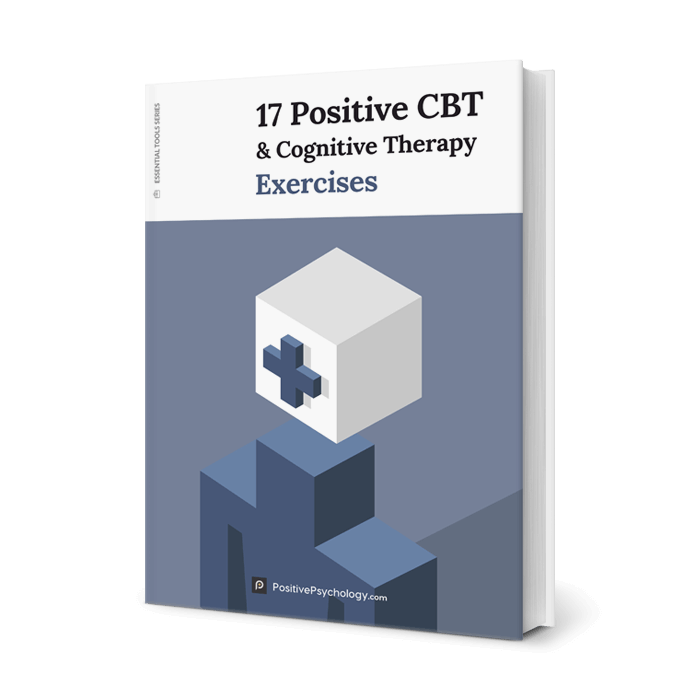Expressive Arts Therapy: 15 Creative Activities and Techniques
 Expressive arts therapy is a multimodal holistic health intervention that mobilizes creative expression in the service of healing both mind and body.
Expressive arts therapy is a multimodal holistic health intervention that mobilizes creative expression in the service of healing both mind and body.
It is especially well suited to clients who lack the ability to articulate their inner world with words alone. These clients can use the many forms of creative arts to express themselves.
In this article, we will discuss expressive arts therapy by explaining the interventions used and the difference between expressive arts therapy and creative arts therapies. You will be introduced to expressive arts therapy techniques and ideas for your psychotherapy and counseling sessions, both with individual adults and groups.
The article will also introduce training programs and degrees in expressive arts therapy and present a brief review of some of the best books on the subject.
Before you continue, we thought you might like to download our three Positive CBT Exercises for free. These science-based exercises will provide you with detailed insight into Positive CBT and give you the tools to apply it in your therapy or coaching.
This Article Contains:
- What Is Expressive Arts Therapy?
- Expressive Arts Therapy vs Creative Arts Therapy
- 12 Techniques and Ideas for Your Sessions
- 3 Activities for Adults and Groups
- Training in Expressive Arts Therapy
- Top 14 Courses, Programs, and Degrees
- 3 Best Books About Expressive Arts Therapy
- Helpful PositivePsychology.com Resources
- A Take-Home Message
- References
What Is Expressive Arts Therapy?
Expressive arts therapy incorporates elements of all forms of creative expression into a multimodal expressive form of integrative psychotherapy (Knill et al., 2005).
Expressive arts therapists are proficient in interpreting creative expression, rather than arts practitioners who have trained in a specific form of therapy.
In expressive arts therapy, each client is encouraged to use multiple forms of creative expression to articulate their inner world, including drawing and painting, photography, sculptures using a range of materials from clay to paper mâché, music, drama and role-play, poetry, prose, and dance and movement.
Expressive arts therapy focuses on four major therapeutic modalities:
- Expression
- Imagination
- Active participation
- Mind–body connection
Human beings have used expressive arts as healing modalities since ancient times (Malchiodi, 2020). Expressive arts therapists facilitate multimodal creative expression, sometimes in one session, usually non-directively.
In other words, the therapist provides the materials, equipment, and media required to facilitate a client’s creative expression during the therapy session.
Dr. Cathy Malchiodi is a psychologist and expressive arts therapist who explains the four core healing practices when using expressive arts to work with trauma: movement, sound, storytelling through image, and silence through contemplative and self-regulatory practices.
Expressive Arts Therapy vs Creative Arts Therapy
Expressive arts therapy involves a multimodal integration of varied elements of the creative arts therapies into psychotherapy and counseling.
Creative arts therapies include art therapy, dance therapy, music therapy, drama therapy, and writing therapy. Creative arts therapists tend to be expert arts practitioners in one specific area who have gone on to train in a specific type of creative arts therapy (Stuckey & Nobel, 2010).
For example, a painter who has graduated with a fine art degree may then complete graduate training in art therapy to practice as an art therapist, or a professional performer may train as a dance or drama therapist.
However, expressive arts therapists are not expert arts practitioners. Rather, they are proficient in the skilled use of expressive arts as an integrative intervention in psychotherapy (Knill et al., 2005).
12 Techniques and Ideas for Your Sessions

1. Drawing and painting
Intuitive drawing and painting with pastels, chalks, acrylics, and watercolors can be useful for expressing emotions, mood states, or relational dynamics that are difficult to express in words (Laws & Conway, 2019; Stuckey & Nobel, 2010; Trevisani et al., 2010).
Take a look at the video under the next item for an example of an intuitive drawing session.
2. Sculpting
Clay sculpting during a session can be very therapeutic, as clay is moldable and remoldable. Clay can take a lot of impact, and sculpting can be used to represent abstract inner states, a self-image, and other people (Vaartio-Rajalin et al., 2020). It can then be stretched, pummeled, and flattened as a means of expressing emotions.
In the video below, expressive arts therapist Natalie Rogers uses the two techniques mentioned during a therapy session with the same client.
3. Masks
Mask making using a range of materials such as tissue paper, clay, or paper mâché can be a powerful tool for expressing the many different roles people play in different relationships and life situations (Jones, 1996).
It can also express personal strengths. In this article, art therapists Gioia Chilton and Rebecca Wilkinson describe how they use mask making while working with people in addiction recovery.
4. Movement
Movement can be a powerful form of self-expression to connect to the wisdom of the body and its innate healing capacity. This may include dance, but not necessarily.
Movement can relieve stress and can be a powerful tool for self-regulation (Jones, 1996). In the video below, somatic psychologist and dance/movement therapist Dr. Jennifer Tantia explains how she used movement to transform her client’s anxiety into a sense of agency.
5. Writing
Expressive journal writing can combine words, drawings, sketches, collages, or photos to represent emotions, thoughts, events, memories, aspirations, strengths, and other inner experiences.
The journal provides a safe place for a client to express their authentic voice and practice honest self-expression (Knill & Atkins, 2020).
It can help clients clarify thoughts and feelings and forge a deeper connection to their needs, aspirations, and goals. This activity can also be continued between sessions as an adjunct to therapy then discussed during sessions. In this article, expressive arts therapist Shelley Klammer explains the wider benefits of expressive journaling.
6. Poetry
Poetry writing is a central technique in expressive arts therapy that aims to mobilize artistic language, symbolism, and poesy as the source of creative expression. Clients can be encouraged to write expressively but also share poems written by others that have moved them.
The video below is the trailer for the book Poetry in Expressive Arts: Supporting Resilience Through Poetic Writing by Margo Fuchs Knill and Sally Atkins (2020) and presents examples of poetry written as therapy.
7. Role-play
We all play many roles in our lives – at work, in social situations, and in our relationships.
Drama therapy is a safe method for exploring these roles in a nonthreatening way (Jones, 1996). Masks and puppets can also be used to explore roles and express difficult feelings rather than participating in active role-play if a client is uncomfortable expressing themselves directly.
This drama therapy intervention enables clients to explore roles they dislike, roles they aspire to play in the future, and current roles they’d like to expand. Role-play may be used in interventions designed to enhance self-awareness, strengthen a sense of identity, and enhance relationships.
8. Collage
Collage can be used to make emotionally expressive images using cut-outs, photos, paints, and felt pens. The key to this exercise is working quickly and spontaneously, as free of internal verbal commentary as possible.
The expressive collage-making exercise by expressive arts therapist Shelley Klammer in the video below is designed to enhance self-acceptance.
9. Self-portraiture
Self-portraiture using a range of materials can be very cathartic, and a series of self-portraits can reflect how a client sees themselves changing over time. These can be made by drawing, painting, mask making, sculpture, photography, or mixed media using a combination of these materials.
10. Photography
Photography used in a therapeutic context is often called photo therapy or therapeutic photography (Gibson, 2018).
Photo therapy can enhance clients’ appreciation of their environment and what they love about their daily life. It can also be used to journal the healing process after trauma or loss.
In the TED Talk below, How Photography Saved My Life, Bryce Evans explains how therapeutic photography helped him recover from depression and anxiety.
11. Mandala making or coloring
Mandala making or coloring can be a wonderfully meditative exercise for emotional expression, centering, and self-soothing.
Mandala derives from the Sanskrit word for “circle,” and in Eastern religious traditions, mandalas are often used as an aid to contemplation and meditation.
To make a mandala from scratch, the client needs to draw a circle (perhaps tracing around a circular object or using a compass) and then fill the circle in with spontaneous patterns and colors.
Alternatively, mandala coloring books such as 150 Mandalas: An Adult Coloring Book With 150 Beautiful Mandalas in Various Styles for Stress Relief and Relaxation can be used to relieve stress and for self-soothing purposes (Koo et al., 2020).
12. Filmmaking
Filmmaking is another powerful expressive art form that is now available to most of us, given we can all make videos with our smartphones and edit them with various low-cost or free video-editing apps online.
This video trailer for the book Video and Filmmaking as Psychotherapy (Cohen et al., 2016) gives a taste of how filmmaking is being used in psychotherapy with veterans to treat post-traumatic stress disorder.
All the techniques above are used in expressive arts therapy in conjunction with person-centered, psychodynamic, cognitive-behavioral, and mindfulness-based approaches to maximize and integrate psychological healing.
3 Activities for Adults and Groups
We share three activities with which to get started.
1. Mindful painting for stress relief
For this activity, you will need drawing pencils, ink pens, felt pens, colored pencils, pastels, chalks, crayons, acrylic and/or water paints, and brushes. This activity can be conducted with an individual or in a group.
The activity involves intuitively drawing or painting abstract representations of the things that stress your clients in response to the prompt ‘pressure.’ The idea is for clients to express how pressure makes them feel by making marks on the paper without judgment, rather than holding them in their bodies.
This exercise should begin with a brief mindful breathing exercise for each participant to relax and register their stress levels. Then, encourage them to make marks with colors that represent their feelings and draw and paint their problems away.
This video by Mindful Creative Muse for World Mental Health Day explains the process in more detail.
2. Guided imagery with music into a safe place
This activity can be conducted with individuals or in a group and was devised by music therapist Paula Higgins. For this activity, you will need space for clients to sit or lie down, yoga mats or cushions for them to lie on, and a device that can play music either using the video below or your own source.
The activity uses relaxation, guided imagery, music, and the mindfulness of breathing to create a sense of safety and stability. It could be particularly helpful for clients who are grieving, experiencing stress or anxiety, or in recovery from addiction.
You can download the transcript by clicking on the three dots on the right-hand side under the video and then clicking “open transcript.” You can copy and paste the transcript from the text box on the right. Adapt it for your session.
3. Mindful photography as phototherapy
This activity is again suitable for individuals or a group and involves slowing down through mindfully looking at photos to relieve stress through appreciation. Ruth Davey, the founder/director of Look Again has made a short video to give a taste of mindful photography and its benefits.
For this activity, each participant will need access to a digital camera of some sort. A mobile phone camera is more than adequate. Access to nature in either a garden or park is also preferable (Atkins & Snyder, 2017), as it’s much easier to slow down in nature than in a busy urban setting.
Participants benefit by relaxing, becoming more present, and through an enhanced sense of creativity and flow.
Training in Expressive Arts Therapy
The International Expressive Arts Therapy Association has a searchable list of training programs. The following are some of the top courses available, from certificates to diplomas and degrees up to PhD.
Some are offered purely remotely, some are hybrid courses that combine a residential component with online learning, and some are campus based. Most of the training programs are currently based in the United States. There is also one training institute in Europe and one in Hong Kong, with new trainings emerging all the time.
Top 14 Courses, Programs, and Degrees
The best place to get started with expressive arts, is by learning more about it. Have a look at the following selection of courses, spread out over the globe.
1. Expressive Arts Florida Institute
The following courses range from an introductory online program to a series of campus-based master’s degrees in expressive arts therapy in conjunction with other approaches, such as coaching, conflict resolution, and peacebuilding.
- Creative Wisdom – Introductory Online Training in Expressive Arts
- Certificate Training Program in Intermodal Expressive Arts
- Master of Arts Degrees in Expressive Arts Therapy; Expressive Arts Coaching and Consulting; and Conflict Transformation and Peacebuilding (offered in conjunction with the European Graduate School, Switzerland).
2. Lesley University, Cambridge, MA, United States
Lesley University has a range of on-campus courses available from undergraduate to graduate certifications and a doctoral program.
- BA in Expressive Therapies
- Certificate of Advanced Graduate Study in Expressive Therapies
- Graduate Certificate in Expressive Therapies Studies for mental health professionals
- PhD in Expressive Therapies – low residency
3. Appalachian State University, Boone, NC, United States

- Degree in Clinical Mental Health Counseling with a Concentration in Expressive Arts Therapy
- Graduate Certificate in Expressive Arts Therapy
4. The European Graduate School (EGS), Saas-Fee, Switzerland
The courses listed below and other programs at EGS are the only expressive arts therapies training options currently available in Europe.
They offer hybrid study options that comprise a residential component on campus in Switzerland with other studies conducted at a university in your home country. Programs include the following:
- Continuing Education CAS Expressive Arts Practice
- Certificate of Advanced Graduate Study in Expressive Arts
- MA degrees in the fields of expressive arts therapy
- Doctoral program
5. The University of Hong Kong, Centre of Behavioral Health, Hong Kong
This graduate degree program with a duration of two years full time or three years part time at Hong Kong University is the only one available in Asia.
3 Best Books About Expressive Arts Therapy
These books are highly recommended and created by experts in the field.
1. Principles and Practice of Expressive Arts Therapy: Toward a Therapeutic Aesthetics – Paolo J. Knill, Stephen K. Levine, and Ellen G. Levine
This book begins by describing the philosophical foundations of expressive arts therapies in poiesis (creating by making) as an antidote to mind–body dualism and modern alienation as the root cause of many mental health problems.
This book will really appeal to practicing psychotherapists who want to understand how to incorporate expressive arts techniques into their existing approach.
Find the book on Amazon.
2. Nature-Based Expressive Arts Therapy – Sally Atkins and Melia Snyder
This book is also aimed at practicing therapists and helping professionals with an interest in expressive arts and ecotherapy.
This book explains how environmentally aware creative expression can be used to heal the relationship between human beings and nature that can exacerbate and even cause mental health problems from an ecotherapy perspective.
Find the book on Amazon.
3. Trauma and Expressive Arts Therapy: Brain, Body, and Imagination in the Healing Process – Cathy A. Malchiodi
This book is specifically aimed at therapists and helping professionals who work with trauma.
Malchiodi explains the neuroscience of trauma and how expressive arts can reprogram the nervous system through holistic acts of creative expression, by helping to process traumatic experiences that often evade language.
Find the book on Amazon.
Helpful PositivePsychology.com Resources
PositivePsychology.com has free resources that can help you introduce expressive arts interventions into your practice.
Try our Self-Love Journal worksheet, which provides 10 journal prompts for those clients needing to cultivate self-compassion.
Alternatively, try our Mapping Emotions worksheet, which uses visualization and color to enhance emotional awareness.
Our Positive Psychology Toolkit© also contains numerous expressive arts therapy tools, including Rewriting the Narrative With Humor, a tool for promoting emotional wellbeing and resilience using writing therapy to reframe a narrative about an embarrassing event with humor.
Also in the Toolkit is Drawing Grief, an expressive arts tool that aims to help bereaved clients explore their thoughts and feelings about their loss through drawing.
If you’re looking for more science-based ways to help others through CBT, this collection contains 17 validated positive CBT tools for practitioners. Use them to help others overcome unhelpful thoughts and feelings and develop more positive behaviors.
A Take-Home Message
Some pre-linguistic symptoms from trauma, grief, addiction, and anxiety may be inaccessible to conventional language processing. New neural pathways can be built through creative expression, which is a much more potent approach than talking.
Expressive arts therapy is an intervention that can help heal the body and mind, with ancient roots in ritual, music, song, art, poetry, dance, and drama across all cultures.
And although this approach is relatively new to Western psychotherapy, it is growing in relevance as our understanding of the functioning of the brain and nervous system explains why expressive arts therapy can be so effective.
We hope you enjoyed reading this article. For more information, don’t forget to download our three Positive CBT Exercises for free.
- Atkins, S., & Snyder, M. (2017). Nature-based expressive arts therapy: Integrating the expressive arts and ecotherapy. Jessica Kingsley.
- Cohen, J. L., Johnson, J. L., & Orr, P. (2016). Video and filmmaking as psychotherapy: Research and practice. Routledge.
- Gibson, N. (2018). Therapeutic photography: Enhancing self-esteem, self-efficacy and resilience. Jessica Kingsley.
- Jones, P. (1996). Drama as therapy: Theatre as living. Routledge.
- Knill, M. F. & Atkins, S. (2020). Poetry in expressive arts: Supporting resilience through poetic writing. Jessica Kingsley.
- Knill, P. J., Levine, E. G., & Levine, S. K. (2005). Principles and practice of expressive arts therapy: Toward a therapeutic aesthetics. Jessica Kingsley.
- Koo, M., Chen, H. P., & Yeh, Y. C. (2020). Coloring activities for anxiety reduction and mood improvement in Taiwanese community-dwelling older adults: A randomized controlled study. Evidence-Based Complementary and Alternative Medicine, 2020, 6964737.
- Laws, K. R., & Conway, W. (2019). Do adjunctive art therapies reduce symptomatology in schizophrenia? A meta-analysis. World Journal of Psychiatry, 9(8),107–120.
- Malchiodi, C. A. (2020). Trauma and expressive arts therapy: Brain, body, and imagination in the healing process. Guilford Press.
- Stuckey, H. L. & Nobel, J. (2010). The connection between art, healing and public health: A review of current literature. American Journal of Public Health, 100(2), 254–263.
- Trevisani, F., Casadio, R., Romagnoli, F., Zamagni, M. P., Francesconi, C., Tromellini, A., Di Micoli, A., Frigerio, M., Farinelli, G., & Bernardi, M. (2010). Art in the hospital: Its impact on the feelings and emotional state of patients admitted to an internal medicine unit. The Journal of Alternative and Complementary Medicine, 16(8), 853–859.
- Vaartio-Rajalin, H., Santamäki-Fischer, R., Jokisalo, P., & Fagerström, L. (2020). Art making and expressive art therapy in adult health and nursing care: A scoping review. International Journal of Nursing Science, 8(1),102–119.
Let us know your thoughts
Read other articles by their category
- Body & Brain (50)
- Coaching & Application (57)
- Compassion (26)
- Counseling (51)
- Emotional Intelligence (24)
- Gratitude (18)
- Grief & Bereavement (21)
- Happiness & SWB (40)
- Meaning & Values (26)
- Meditation (20)
- Mindfulness (45)
- Motivation & Goals (45)
- Optimism & Mindset (34)
- Positive CBT (29)
- Positive Communication (20)
- Positive Education (47)
- Positive Emotions (33)
- Positive Leadership (18)
- Positive Parenting (4)
- Positive Psychology (33)
- Positive Workplace (37)
- Productivity (17)
- Relationships (46)
- Resilience & Coping (38)
- Self Awareness (21)
- Self Esteem (38)
- Strengths & Virtues (32)
- Stress & Burnout Prevention (34)
- Theory & Books (46)
- Therapy Exercises (37)
- Types of Therapy (64)












What our readers think
This is great! This is my first experience with art expression therapy, and I was left with so many resources. As a future counselor, I am so excited and have so many excellent resources. Thank you so much.
Dr. Jo, thanks for citing me and sharing the film! I appreciate it! What a great website, too. I have it bookmarked.